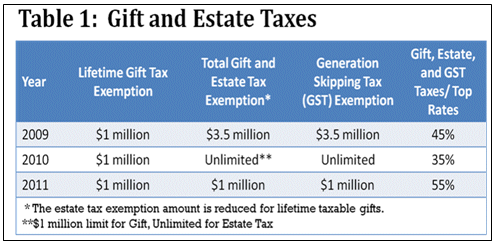Jose G. Peña, Texas AgriLife Extension Economist-Management
The federal estate tax was repealed at the end of 2009. Estate taxes are scheduled to return in 2011 at exemption rates that applied 10 years ago, unless Congress passes legislation soon to remedy the scheduled changes to the estate tax. If Congress fails to pass legislation, the gift and estate tax exemption drops to $1.0 million per individual estate in 2011, with a top marginal tax rate of 55 percent on the remainder of the estate.
The Economic Growth and Tax Relief Reconciliation Act of 2001 (EGTRRA) had gradually increased the estate tax exemption rates to $3.5 million/estate by 2009 with a top marginal rate of 45 percent for the remainder of the estate (see table 1). Due to the Byrd Rule, which limits laws with a negative fiscal impact to 10 years, Congress instituted a 10-year sunset provision to the legislation, with a suspension in 2010. This means that the federal estate tax exemption revert to 2001 levels in 2011. The EGTRRA repealed the estate tax in 2010. So, unless Congress comes up with a remedy, which could be implemented retroactively to January 1, 2010, estates transfers in 2010 are not subject to federal estate taxes, but starting on January 1, 2011, only $1.0 million (valued at fair market value) will be exempt from federal estate taxes. The remaining value of the estate will be subject to a 55 percent top marginal tax rate.
 Some contend that Congress can make the estate tax retroactive to January 1, 2010. Others feel that reinstituting the estate tax on a retroactive basis would be unconstitutional (since the estate tax was repealed, passing a retroactive estate tax would be similar to an unconstitutional fine)
Some contend that Congress can make the estate tax retroactive to January 1, 2010. Others feel that reinstituting the estate tax on a retroactive basis would be unconstitutional (since the estate tax was repealed, passing a retroactive estate tax would be similar to an unconstitutional fine)
Passing legislation to remedy the situation will be difficult since congressmen are far apart on the issue. In early December 2009, the House passed the Permanent Estate Tax Relief for Families, Farmers, and Small Businesses Act of 2009 (H.R. 4154). After several year-end parliamentary maneuvers, the bill failed to win support in the Senate, as did a temporary stop-gap measure to extend the 2009 estate tax regime through March 2010. HR4154 would have permanently extended the top federal estate tax rate of 45 percent with a $3.5 million exclusion ($7 million for married couples who fully utilize their exclusions). The bill would have also continued the gift and generation-skipping transfer (GST) tax provisions as they existed in 2009.
Step-up vs. Carry-over Basis
Probably the most controversial and confusing aspect of EGTRAA is that for 2010 it replaced the estate tax carry-over basis rules. Under the law that was in effect up until 2009, assets owned at death received a “step-up” basis to a fair market value at death. For example, if a landowner died owning land (and or other assets) purchased many years ago, the heirs could inherit and could sell the land (and other assets) at the fair market value at the time of decedents death (or the FMV 6 months later) and pay little or no capital gains tax (though the value of the land and other assets would have been subject to estate taxes at their fair market value on the date of death or 6 months after). The only capital gains tax that would be paid if the land or assets were later sold would be based on the difference between the sale price and fair market value at time of death.
Under the EGTRAA, in 2010, estate transfers would not be subject to estate taxes since estate taxes were repealed (unless Congress comes up with retroactive legislation), but a beneficiary would receive property with an adjusted basis equal to the lesser of the decedent’s basis or the asset’s fair market value at the date of death. This means the automatic “step up” in basis is eliminated at death but retains the “carry-over” basis for depreciating assets. To offset this loss, EGTRRA provides the executor or any other person responsible for the decedent’s property an opportunity to allocate, a $1.3 million “aggregate” increase on an asset by asset basis. Assets left outright to a spouse receive an additional $3 million “spousal property basis increase”. While this $1.3 million ($4.3 to spouse) aggregate step-up in basis may be adequate for small estates, keep in mind the record-keeping, documentation, allocation decisions and many other problems which larger estates could encounter.
Bypass Trusts
Another potential consequence of repealing estate taxes in 2010, is that formula clauses in will, trust and other estate transfer documents which include wording to shift assets from the spouse to other beneficiaries, may create problems for estate transfers in 2010. These clauses were intended to take maximum advantage of the estate tax exemption which kept increasing.
During 2010, since the estate tax is repealed, the maximum exemption is unlimited. Depending on how a formula clause is worded, it is possible that everything will go into the bypass trust and the surviving spouse could get nothing. Even if the trust benefits the surviving spouse, all the money could be locked up in the trust.
Estate plans should be carefully reviewed. A simple codicil can fix the problem.
Appreciation is expressed to Sherman Mumme, CPA for his contribution to and review of this article.
